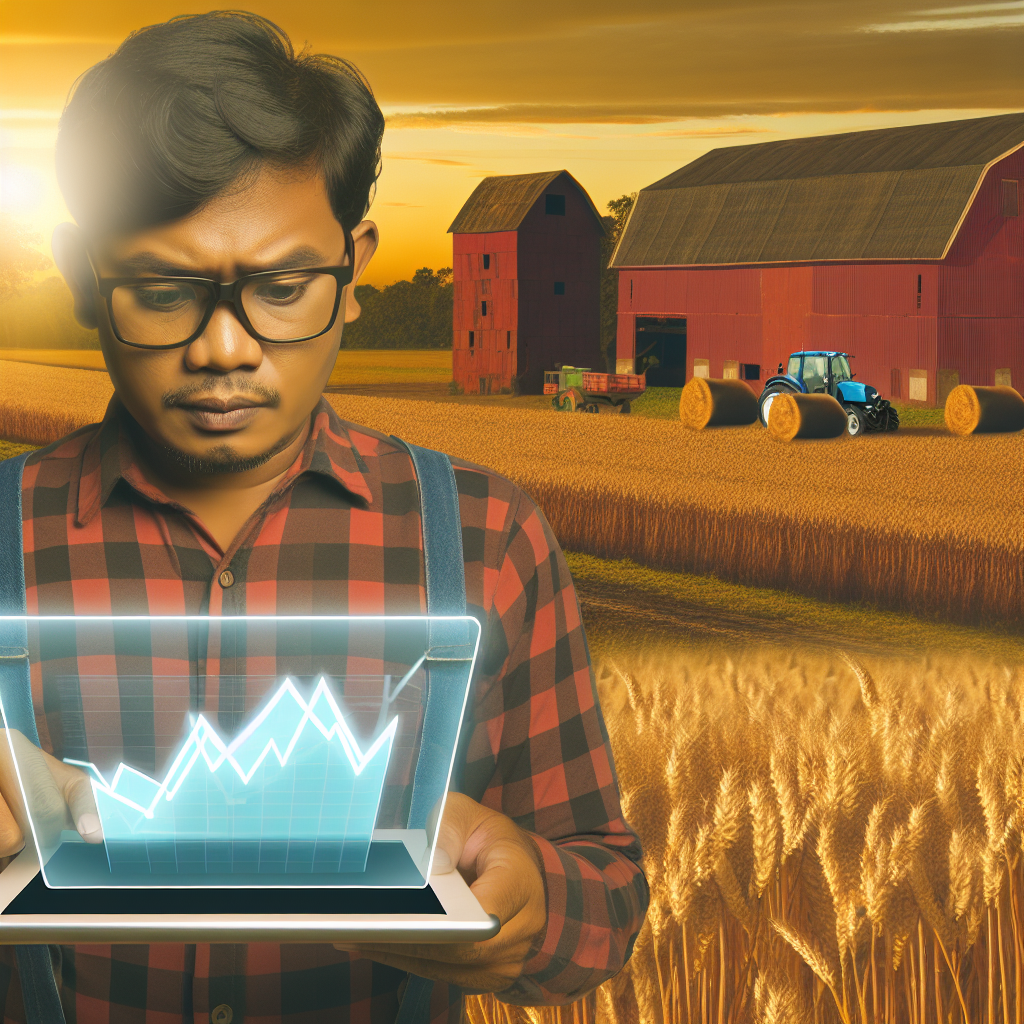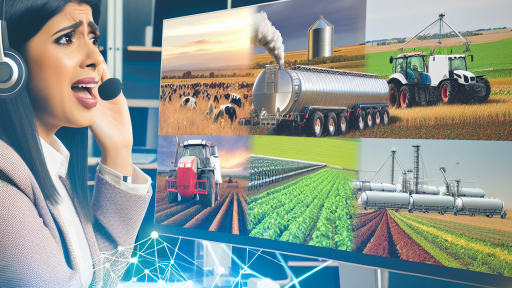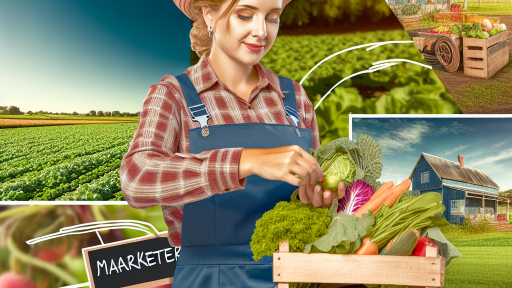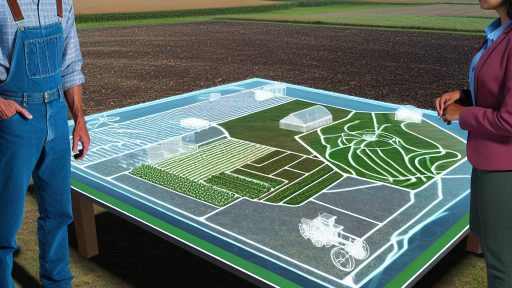Overview of Climate Change and Its Relevance to Farming
Climate change significantly affects farming throughout the world.
It contributes to unpredictable weather patterns that impact crop yields.
Farmers today face challenges such as droughts and floods.
These environmental changes can disrupt traditional farming practices.
Current Trends in Climate Change
Recent studies show that global temperatures are rising steadily.
This rise leads to more extreme weather events across regions.
As a result, farmers must adapt to these changing conditions.
Moreover, changes in precipitation patterns affect water availability.
Impact on Crop Production
Climate change directly influences crop production levels.
Some regions may experience reduced agricultural output.
In contrast, other areas might benefit from longer growing seasons.
Consequently, it’s crucial for farmers to track these shifts closely.
Shifts in Market Demand
Consumer preferences are changing due to climate concerns.
Many people now prefer sustainably grown products.
This shift influences farming methods and market trends.
Transform Your Agribusiness
Unlock your farm's potential with expert advice tailored to your needs. Get actionable steps that drive real results.
Get StartedFarmers must respond by adopting environmentally friendly practices.
Technological Adaptations
New technologies can help mitigate the effects of climate change.
These include precision agriculture techniques and drought-resistant crops.
Farmers also utilize data analytics to optimize their operations.
Such innovations enable better decision-making and resource management.
Collaborative Efforts
Addressing climate change requires collective action from various stakeholders.
Farmers, governments, and organizations must collaborate effectively.
These collaborative efforts can lead to sustainable farming solutions.
Additionally, sharing knowledge and resources is vital for success.
Direct Effects of Climate Change on Crop Yields
Changing Temperature Patterns
Climate change leads to rising average temperatures globally.
These temperature increases directly affect crop growth rates.
As a result, certain crops may yield less under extreme heat.
Additionally, some regions experience hotter nights.
These warmer nights can hinder nighttime recovery for crops.
Consequently, plants may become more susceptible to disease.
Altered Precipitation Regimes
Changes in precipitation significantly impact farming conditions.
In some areas, rainfall becomes more erratic and unpredictable.
This unpredictability challenges farmers to plan plantings effectively.
Excessive rainfall can lead to flooding, damaging crops.
Conversely, prolonged droughts can severely limit yields.
Farmers must adapt their practices to these new conditions.
Increased Pest and Disease Pressure
Climate change results in a shift in pest and disease dynamics.
Warmer temperatures allow pests to thrive in new areas.
Additionally, changing climates can increase disease prevalence.
Showcase Your Farming Business
Publish your professional farming services profile on our blog for a one-time fee of $200 and reach a dedicated audience of farmers and agribusiness owners.
Publish Your ProfileCrops may experience more infestations than ever before.
Farmers need to implement integrated pest management strategies.
This involves using sustainable methods to control pests effectively.
Soil Health and Nutrient Availability
Climate change can degrade soil quality over time.
Changes in weather patterns affect soil moisture levels.
Wet soils can lead to erosion, removing vital nutrients.
Conversely, dry soils can hinder nutrient uptake by plants.
Farmers must adopt practices that improve soil health.
Such practices include crop rotation and cover cropping.
Regional Variability in Crop Viability
The impact of climate change varies by region.
Some crops may thrive in warmer climates, while others decline.
Farmers must research suitable crops for their local conditions.
Adaptation strategies may include switching to more resilient varieties.
Consequently, understanding regional climate effects is essential.
Farmers need ongoing education and resources for successful adaptation.
Shifts in Crop Production Areas Due to Climate Adaptations
Geographical Changes in Crop Viability
Climate change significantly alters agricultural geographies.
Farmers now face shifting zones for viable crop production.
Many areas previously ideal for crops are becoming less suitable.
This shift necessitates adaptations in farming practices.
Areas with traditional farming may require new crop varieties.
Farmers must stay informed about climate forecasts.
Consequently, strategic planning becomes essential for success.
Emerging Regions for Agriculture
New regions are becoming viable for certain crops.
Some northern areas now see opportunities for agriculture.
This trend includes places like Canada and northern Europe.
Farmers in these regions can benefit from longer growing seasons.
Emerging markets can help meet global food demands.
It is important to explore local soil conditions.
Farmers should assess water availability for irrigation.
Increasing Demand for Resilient Varieties
As climate patterns shift, resilient crop varieties gain importance.
Farmers increasingly seek drought-resistant options.
These varieties can withstand unpredictable weather events.
Additionally, new pest-resistant crops are becoming essential.
Farmers need education on sustainable pest management.
Collaboration with agricultural scientists proves beneficial.
Informed choices lead to successful crop yields.
The Role of Technology in Adaptation
Technology plays a vital role in adapting to climate changes.
Precision agriculture helps farmers make informed decisions.
Using data analytics can optimize planting and harvesting times.
Moreover, satellite imagery assists in monitoring crop health.
Showcase Your Farming Business
Publish your professional farming services profile on our blog for a one-time fee of $200 and reach a dedicated audience of farmers and agribusiness owners.
Publish Your ProfileFarmers can now respond swiftly to adverse conditions.
Innovations in irrigation systems enhance water efficiency.
These technologies can mitigate adverse effects of climate change.
Community and Cooperative Efforts
Local communities are crucial in adapting to climate shifts.
Farmers cooperatives foster shared knowledge and resources.
They often facilitate access to new technologies and crops.
Networking with fellow farmers builds resilience in practices.
Community education programs can raise awareness of climate issues.
Such initiatives encourage collaborative problem-solving.
A united approach strengthens regional agriculture against climate impacts.
Find Out More: Future Trends in Sustainable Farming Practices
Impact of Extreme Weather Events on Farming Practices and Market Stability
Understanding Extreme Weather Events
Extreme weather events include droughts, floods, and hurricanes.
These events disrupt farming practices across the globe.
Farmers face increased challenges in crop management and livestock care.
Effects on Crop Production
Extreme weather negatively impacts yield and quality of crops.
Droughts can cause water shortages, stressing plants significantly.
Flooding can lead to soil erosion and nutrient loss.
This ultimately reduces the amount of harvestable produce.
As a result, farmers may face lower incomes during tough seasons.
Impact on Livestock Farming
Extreme weather also affects livestock operations adversely.
Heat stress can reduce fertility and milk production in cattle.
Additionally, flooding can pose health risks to livestock.
Animals may face shortages of feed due to damaged crops.
Consequently, meat and dairy production can drop significantly.
Market Stability Challenges
Market stability often takes a hit during extreme weather events.
Reduced supply leads to increased prices for consumers.
This creates inflationary pressures in the agricultural market.
Farmers must cope with unpredictable income fluctuations.
Moreover, insurance costs can rise as risks increase.
Adapting Farming Practices
Farmers are adapting their practices to be more resilient.
Some are investing in technology for better resource management.
Others are diversifying crops to minimize risk.
Additionally, many are adopting sustainable methods to preserve the environment.
These practices ultimately aim to stabilize production and income.
Policy and Support Systems
Government policies play a crucial role in supporting farmers.
Subsidies and grants can help build resilience against climate impacts.
Farmers also benefit from community resources and training programs.
Furthermore, better infrastructure can mitigate damages during storms.
Sustained support promotes a more stable farming market.
Explore Further: Financial Planning Tips for Farm Succession
Showcase Your Farming Business
Publish your professional farming services profile on our blog for a one-time fee of $200 and reach a dedicated audience of farmers and agribusiness owners.
Publish Your ProfileEconomic Implications of Climate Change on Crop Prices and Farmer Income
Changing Crop Yields
Climate change directly affects crop yields across various regions.
As temperatures rise, some crops may struggle to thrive.
Farmers are experiencing fluctuations in yield quantities and quality.
This inconsistency leads to instability in crop prices.
For example, a drought can significantly reduce soybean production.
Consequently, prices for soybeans may spike due to scarcity.
Price Volatility
The farming market faces increased price volatility due to climate change.
Extreme weather events disrupt supply chains regularly.
Such disruptions create uncertainty for buyers and sellers alike.
Farmers must adapt by navigating these volatile conditions.
They often resort to diversifying crops as a risk management strategy.
This diversification helps stabilize income over time.
Impact on Farmer Income
Farmer income significantly depends on predictable crop yields.
Unpredictable weather can lead to lower incomes for farmers.
Financial stability becomes a concern amid fluctuating market prices.
Additionally, increased production costs can erode profits.
Farmers may need to invest in climate-resilient technologies.
Such investments can alleviate some financial burdens over time.
Adapting to Market Changes
Farmers are continuously adapting to the changing agricultural landscape.
Understanding market trends becomes crucial for their success.
Investing in new farming practices can lead to better long-term outcomes.
Furthermore, educating farmers on market strategies is essential.
Collaboration with agricultural economists offers valuable insights.
Incorporating technology can also enhance market adaptability.
Implications of Climate Change on Agriculture
The economic implications of climate change on farming are profound.
Farmers face challenges with yields, prices, and income stability.
Adaptive measures will be essential for future resilience.
By addressing these challenges, farmers can navigate a changing market.
Understanding these impacts is crucial for long-term sustainability.
See Related Content: Key Strategies For Building Effective Farm Collaborations

Role of Technology and Innovation in Mitigating Climate Effects on Farming
Introduction to Technological Advances
Technology significantly alters farming practices today.
Innovations help farmers adapt to climate change’s adverse effects.
Moreover, new tools enhance efficiency and productivity.
Precision Agriculture
Precision agriculture utilizes data-driven techniques.
This approach allows farmers to optimize resource use.
Farmers can apply the right amount of water, fertilizers, and pesticides.
Consequently, they reduce waste and improve crop yield.
Climate-Resilient Crops
Developing climate-resilient crops is essential for sustainability.
Researchers are creating varieties that withstand extreme weather conditions.
These crops can endure droughts, floods, and temperature fluctuations.
Showcase Your Farming Business
Publish your professional farming services profile on our blog for a one-time fee of $200 and reach a dedicated audience of farmers and agribusiness owners.
Publish Your ProfileAs a result, farmers experience less crop loss.
Data Analytics and Forecasting
Data analytics empowers farmers with critical insights.
Forecasting technologies predict weather patterns and pest outbreaks.
Farmers can make informed decisions based on these predictions.
They can adjust planting schedules and management strategies accordingly.
Automation and Robotics
Automation plays a significant role in modern agriculture.
Robots assist with planting, harvesting, and monitoring crops.
This technology reduces labor costs and boosts efficiency.
Furthermore, automated systems ensure consistent quality.
Renewable Energy Solutions
Integrating renewable energy solutions supports sustainable farming.
Solar panels and wind turbines provide clean energy for operations.
This reduces reliance on fossil fuels and lowers carbon footprints.
Farmers who adopt renewables also decrease operational costs over time.
Soil Management Technologies
Advanced soil management technologies enhance soil health.
These tools monitor soil conditions and nutrient levels.
Farmers can apply amendments precisely based on data.
Consequently, soil fertility improves, leading to better crop yields.
Collaboration and Knowledge Sharing
Collaboration among farmers, scientists, and tech companies is vital.
Sharing knowledge fosters innovation and identifies best practices.
Furthermore, cooperative networks provide resources for all members.
This collaboration strengthens community resilience against climate change.
Find Out More: How to Tap Into Global Markets and Scale Your Farming Business
Consumer Trends and Preferences Shift Due to Climate Awareness
Growing Awareness of Climate Impact
Recent studies show consumers are increasingly aware of climate change.
This awareness significantly influences purchasing decisions.
People prefer brands that prioritize sustainability and eco-friendliness.
Shift Towards Organic and Local Products
Consumers are increasingly interested in organic products.
They believe these products are healthier and environmentally friendly.
Additionally, interest in locally sourced items is rising.
This trend supports local farmers and reduces transportation emissions.
Demand for Transparency from Brands
Shoppers now expect transparency in product sourcing.
They want to know where and how products are made.
Companies are responding by sharing detailed information about their supply chains.
Impact of Social Media on Consumer Choices
Social media plays a vital role in shaping consumer preferences.
Platforms like Instagram and Twitter amplify eco-friendly campaigns.
Brands that engage authentically with sustainability issues gain consumer trust.
Influence of Government Policies on Consumer Behavior
Government initiatives encourage sustainable farming practices.
Incentives make it easier for consumers to choose eco-friendly products.
Policy changes drive public interest in environmentally conscious purchasing.
Emergence of Eco-Conscious Brands
More companies are emerging with a focus on sustainability.
These brands cater to a market eager for environmentally responsible products.
Showcase Your Farming Business
Publish your professional farming services profile on our blog for a one-time fee of $200 and reach a dedicated audience of farmers and agribusiness owners.
Publish Your ProfileConsumer loyalty often leans towards brands that demonstrate commitment to climate action.
Policies and Regulations Supporting Sustainable Farming Practices Amid Climate Change
Government Initiatives
Governments worldwide recognize the need for sustainable farming practices.
As a result, various policies promote environmentally friendly agriculture.
The U.S. Department of Agriculture implements programs to support farmers.
These programs provide funding for sustainable practices and technologies.
Moreover, local governments often offer incentives for eco-friendly farming.
International Agreements
International agreements play a critical role in sustainable farming.
The Paris Agreement encourages countries to adopt green policies.
This includes promoting sustainable agricultural methods to reduce emissions.
Additionally, global organizations advocate for sustainable practices.
They provide resources and guidelines to help farmers adapt.
Subsidies and Grants
Financial support is essential for farmers transitioning to sustainable practices.
Government subsidies can reduce the financial burden of eco-friendly investments.
For instance, grants help farmers install solar panels and irrigation systems.
These initiatives promote energy efficiency and water conservation.
Consequently, farmers can increase productivity while protecting natural resources.
Research and Education
Research institutions conduct studies on sustainable farming techniques.
These studies help identify effective practices for diverse climates.
Furthermore, educational programs train farmers in new methods.
Workshops and seminars enhance farmers’ understanding of sustainability.
With better knowledge, farmers can implement practices that benefit both soil and crops.
Collaboration with NGOs
Non-governmental organizations play a significant role in sustainable farming.
They often partner with farmers to promote best practices.
Organizations such as the Soil Conservation Society offer resources and support.
These collaborations help farmers improve soil health and enhance biodiversity.
Additionally, NGOs advocate for policies that support sustainable agriculture.
Additional Resources
Fourth National Climate Assessment
Climate Change and U.S. Agriculture: An Assessment of Effects and …




